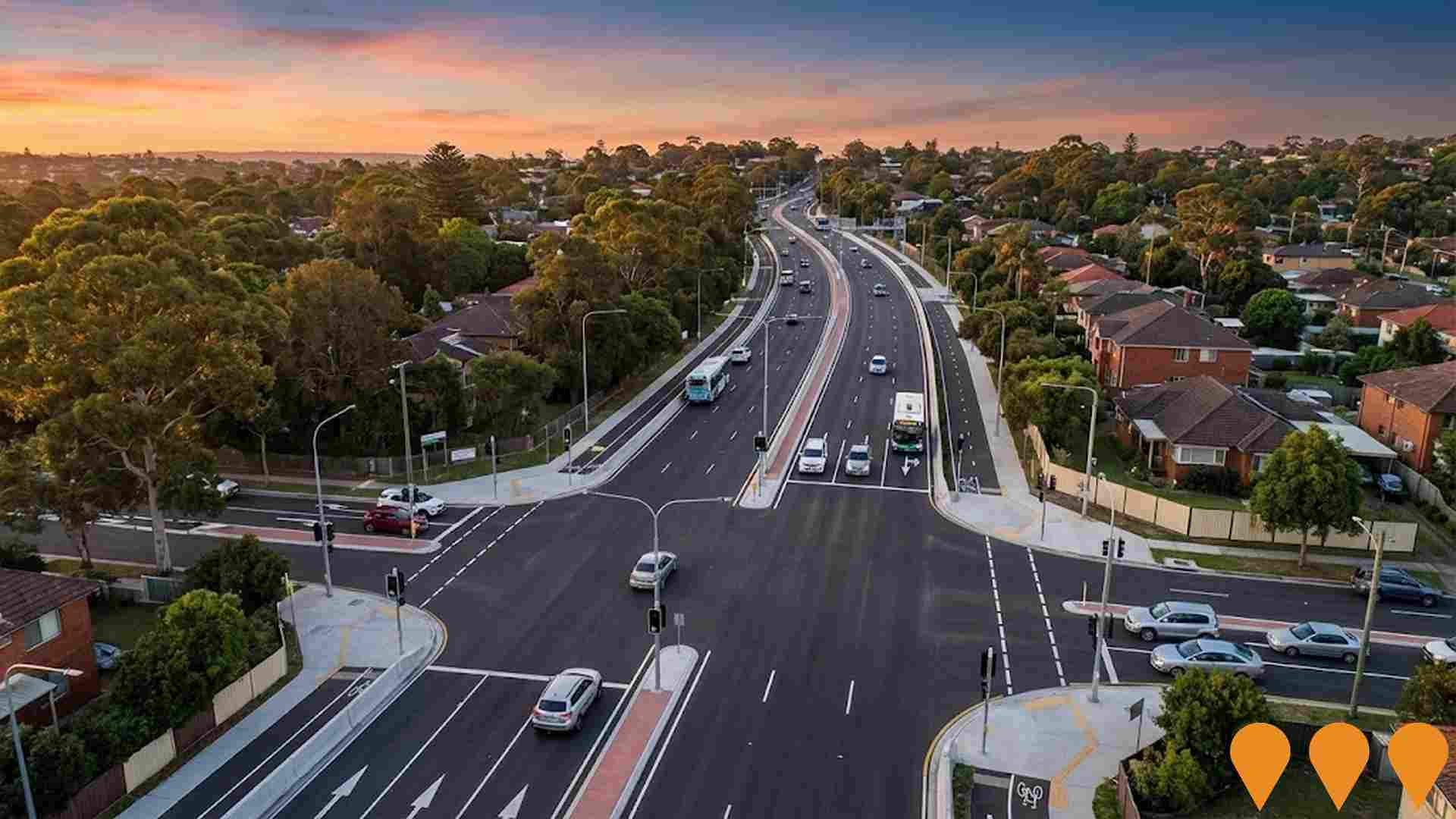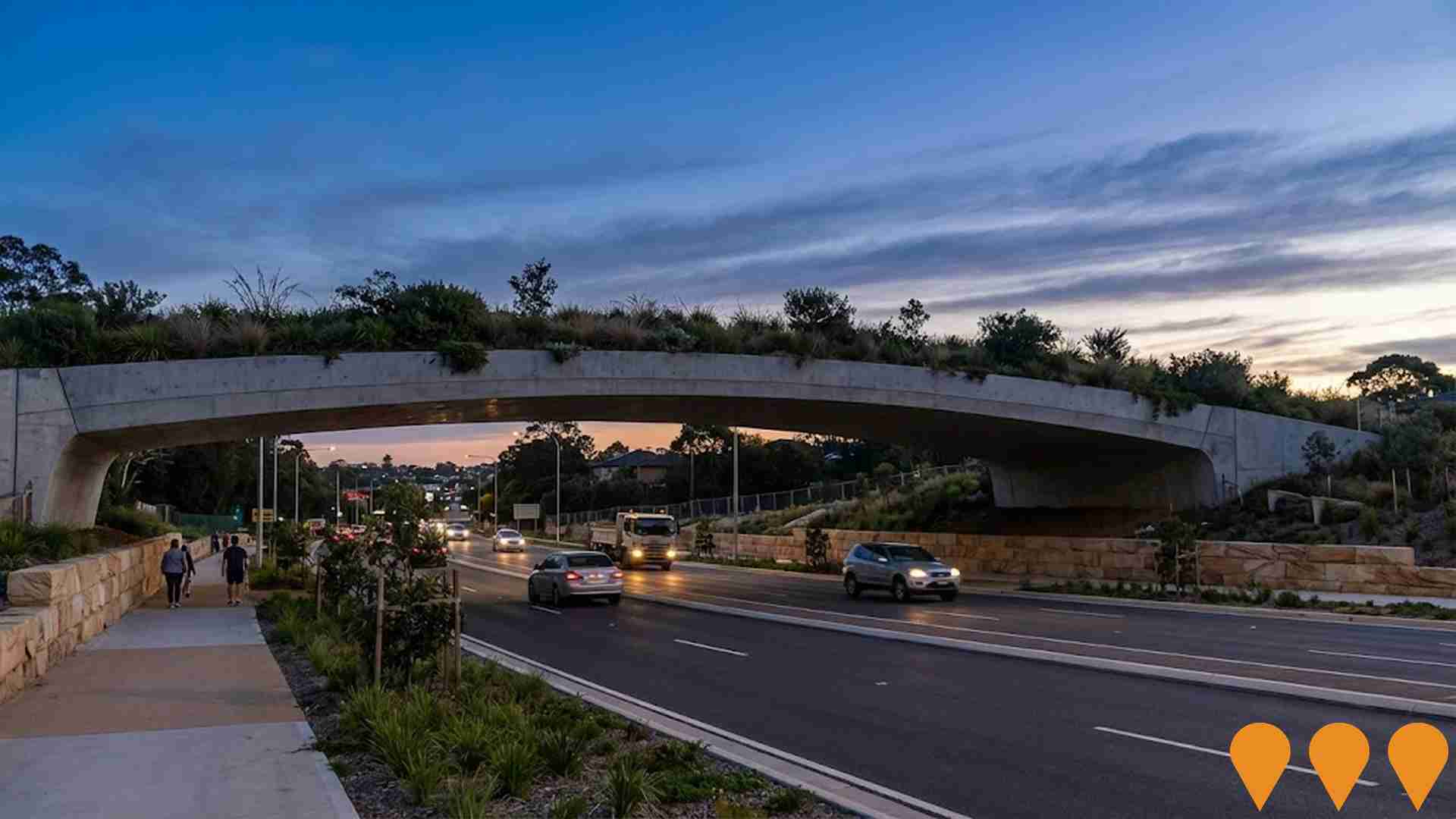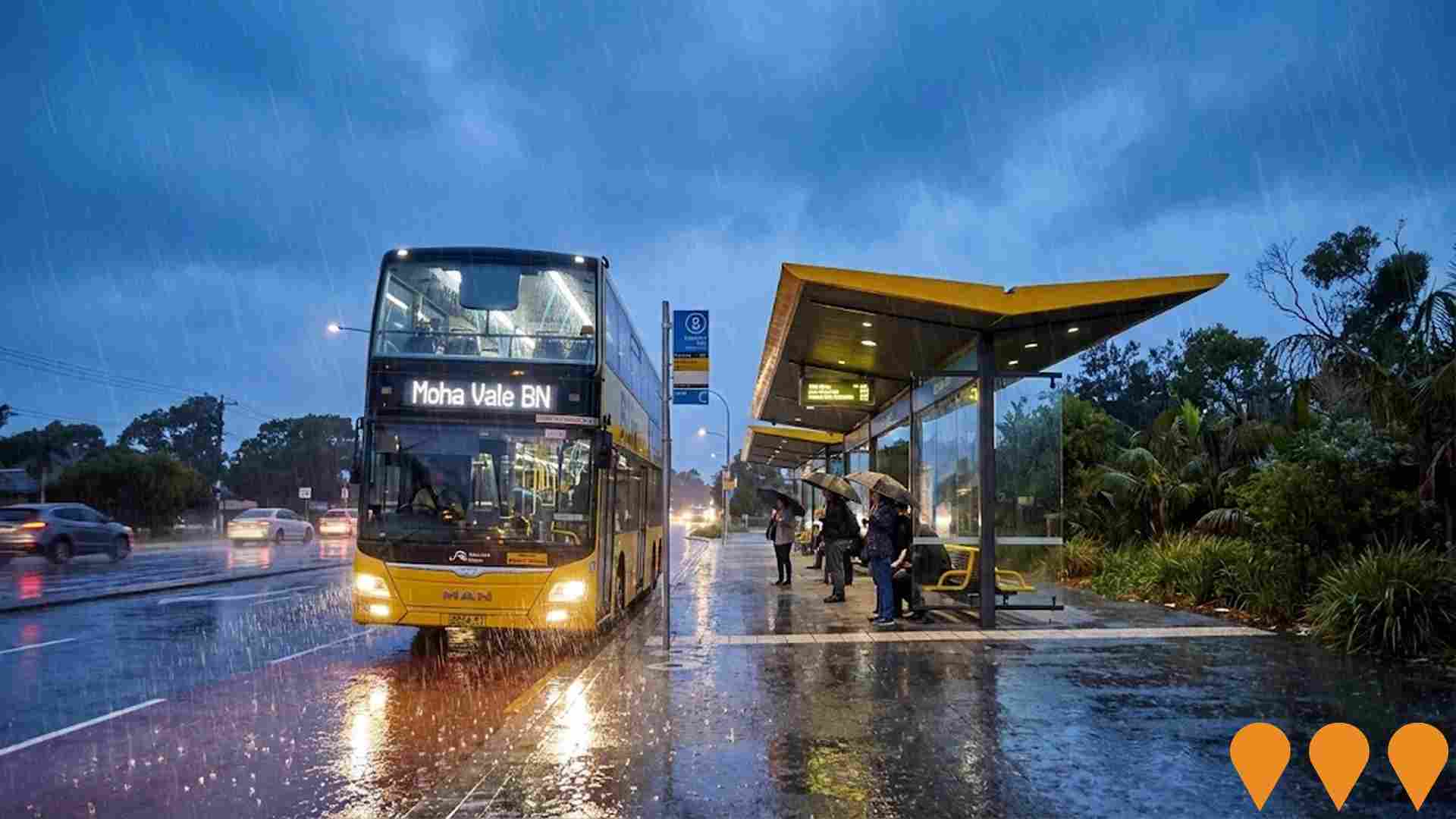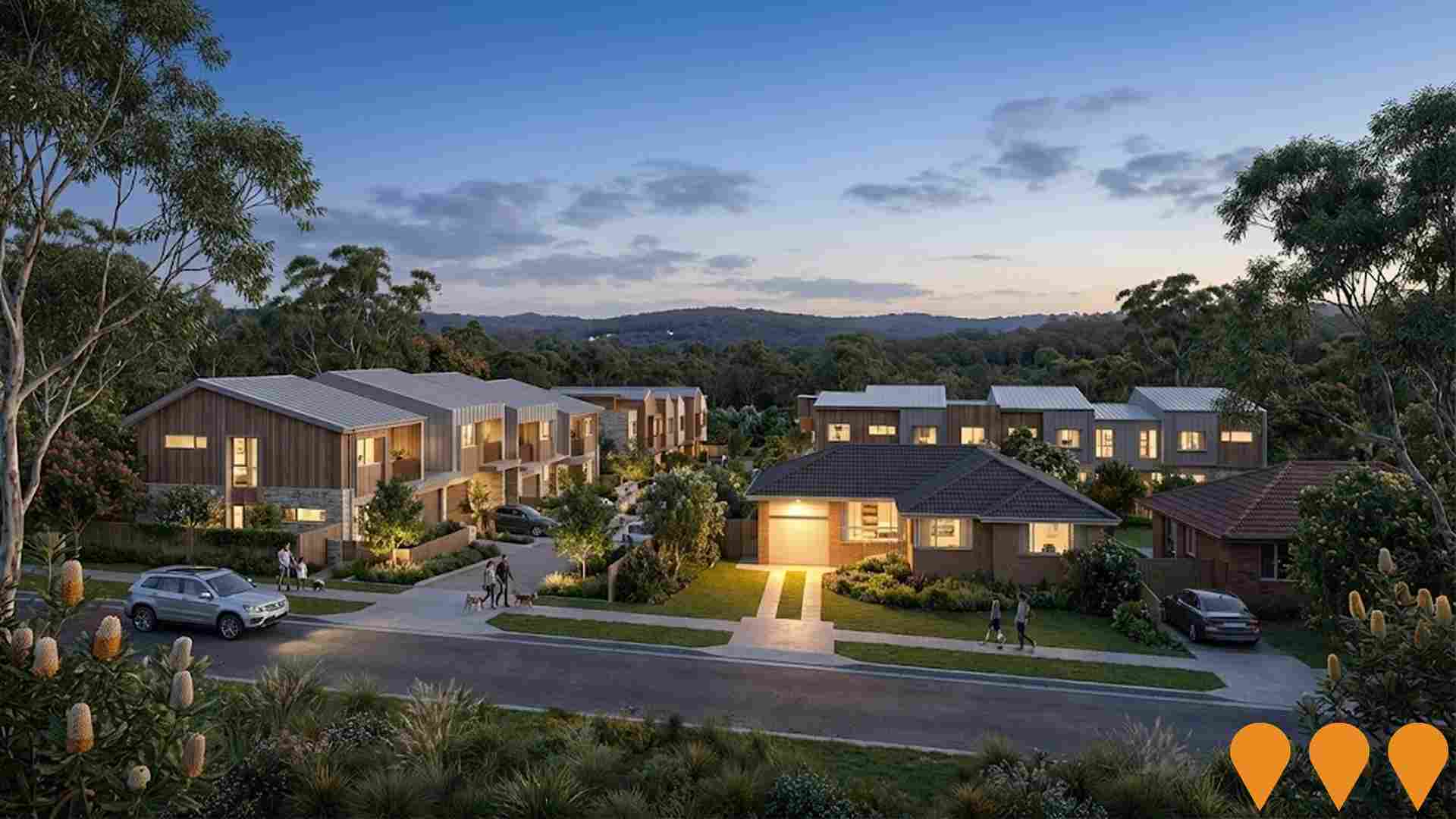Chart Color Schemes
est. as @ -- *
ABS ERP | -- people | --
2021 Census | -- people
Sales Activity
Curious about local property values? Filter the chart to assess the volume and appreciation (including resales) trends and regional comparisons, or scroll to the map below view this information at an individual property level.
Find a Recent Sale
Sales Detail
Population
An assessment of population growth drivers in Terrey Hills - Duffys Forest reveals an overall ranking slightly below national averages considering recent, and medium term trends
Terrey Hills - Duffys Forest's population is around 3,637 as of Aug 2025. This reflects a decrease since the 2021 Census which reported a population of 3,786 people. The change is inferred from ABS estimated resident population of 3,634 in June 2024 and an additional 3 validated new addresses since the Census date. Population density is 51 persons per square kilometer. Overseas migration primarily drove recent population growth.
AreaSearch adopts ABS/Geoscience Australia projections for each SA2 area released in 2024 with a base year of 2022, and NSW State Government's SA2 level projections for areas not covered by this data, released in 2022 with a base year of 2021. Growth rates by age group are applied to all areas from 2032 to 2041. By 2041, the area is expected to grow by 21 persons based on latest population numbers, an increase of 0.4% over 17 years.
Frequently Asked Questions - Population
Development
The level of residential development activity in Terrey Hills - Duffys Forest is very low in comparison to the average area assessed nationally by AreaSearch
Terrey Hills-Duffys Forest has recorded approximately five residential properties granted approval per year over the past five financial years, totalling 28 homes. No approvals have been recorded so far in FY-26. The average construction cost value of new homes is $2,669,000, indicating a focus on the premium market segment. This year, $12.3 million in commercial approvals have been registered, suggesting moderate levels of commercial development.
Compared to Greater Sydney, Terrey Hills-Duffys Forest has roughly half the building activity per person and ranks in the 19th percentile nationally, resulting in relatively constrained buyer choice and supporting interest in existing dwellings. Recent development has consisted entirely of detached dwellings, preserving the area's low density nature and attracting space-seeking buyers. The estimated population count per dwelling approval is 912 people. Population forecasts indicate a gain of 13 residents by 2041.
Based on current development patterns, new housing supply should meet demand, offering good conditions for buyers and potentially facilitating population growth beyond projections.
Frequently Asked Questions - Development
Infrastructure
Terrey Hills - Duffys Forest has strong levels of nearby infrastructure activity, ranking in the top 30% nationally
The performance of an area can significantly be influenced by changes in local infrastructure, major projects, and planning initiatives. AreaSearch has identified a total of 12 projects that are expected to impact the area. Notable projects include the Mona Vale Road West Upgrade (McCarrs Creek Road to Powder Works Road), Connecting Northern Beaches - Cycling & Walking Paths, Belrose North Residential Release, Newcastle-Sydney and Wollongong-Sydney Rail Line Upgrades. The following list provides details on those projects likely to have the most relevance.
Professional plan users can use the search below to filter and access additional projects.
INFRASTRUCTURE SEARCH
 Denotes AI-based impression for illustrative purposes only, not to be taken as definitive under any circumstances. Please follow links and conduct other investigations from the project's source for actual imagery. Developers and project owners wishing us to use original imagery please Contact Us and we will do so.
Denotes AI-based impression for illustrative purposes only, not to be taken as definitive under any circumstances. Please follow links and conduct other investigations from the project's source for actual imagery. Developers and project owners wishing us to use original imagery please Contact Us and we will do so.
Frequently Asked Questions - Infrastructure
Northern Beaches Coast Walk
A 36km continuous coastal walking trail linking Manly to Palm Beach via beaches, headlands and existing paths. The project upgrades and connects existing sections with new boardwalks, viewing platforms, signage and accessibility improvements. Works are staged with multiple sections already complete and major construction underway on remaining gaps, particularly around Narrabeen, Warriewood and North Narrabeen.

Mona Vale Hospital Reconfiguration
NSW Health Infrastructure has completed the reconfiguration of Mona Vale Hospital to focus on rehabilitation, sub-acute and community health services. Works included establishing a 20-bed geriatric evaluation and management and palliative care building (10-bed GEM and 10-bed palliative), creating an urgent care centre from the former ED, a new support services building, helipad relocation, and demolition of redundant buildings. The program complements services at Northern Beaches Hospital and ensures ongoing local access to appropriate care.

Warringah Road Upgrade Project
Major road infrastructure upgrade improving traffic flow and safety along Warringah Road corridor, including new lanes, intersections, and cycling infrastructure.

Newcastle-Sydney and Wollongong-Sydney Rail Line Upgrades
Program of upgrades to existing intercity rail corridors linking Newcastle-Central Coast-Sydney and Wollongong-Sydney to reduce travel times and improve reliability. Current scope includes timetable and service changes under the Rail Service Improvement Program, targeted network upgrades (signalling, power, station works) and the introduction of the Mariyung intercity fleet on the Central Coast & Newcastle Line, alongside Federal planning led by the High Speed Rail Authority for a dedicated Sydney-Newcastle high speed corridor.

Mona Vale Road East Upgrade
Upgrade of 3.2 kilometres of Mona Vale Road from two lanes to four lanes between Manor Road, Ingleside and Foley Street, Mona Vale. Includes new signalised intersection at Ponderosa Parade, fauna overpass bridge, and truck arrester bed. Project completed March 2024.

Wakehurst Parkway Improvements (Frenchs Forest to Narrabeen)
Improvements to Wakehurst Parkway between Frenchs Forest Road and Pittwater Road, North Narrabeen. The project involves intersection upgrades, lane widening for dual lanes in sections, new shared paths, and improved flood resilience to enhance safety, network efficiency, and capacity for future traffic growth on this key Northern Beaches corridor. Planning approval was received in August 2024, with early work and site investigations underway.

Mona Vale Road West Upgrade (McCarrs Creek Road to Powder Works Road)
The Mona Vale Road West Upgrade will expand 3.4 kilometres of Mona Vale Road from two lanes to four lanes between McCarrs Creek Road, Terrey Hills and Powder Works Road, Ingleside. This project aims to improve safety and traffic efficiency. Key features include a new signalised intersection at Kimbriki Road, the relocation of the Tumburra Street intersection, and the construction of a 40-metre fauna bridge and two underpasses to protect local wildlife.

Northern Beaches Bus Network Improvements
Comprehensive upgrade to the Northern Beaches bus network to improve reliability and capacity. The project involves the procurement of 50 new articulated buses and 10 new double-decker B-Line buses, scheduled for delivery by mid-2026. Operational changes commencing January 2025 include new all-night services on Route 144 (Manly to Chatswood), extended services on Route 199, and frequency improvements on key corridors. The program runs in parallel with the $75M+ Wakehurst Parkway improvements to reduce flooding and improve transit reliability.

Employment
Despite maintaining a low unemployment rate of 3.3%, Terrey Hills - Duffys Forest has experienced recent job losses, resulting in a below average employment performance ranking when compared nationally
Terrey Hills-Duffys Forest has an educated workforce with professional services well-represented. The unemployment rate is 3.3%.
As of June 2025, 1911 residents are employed, with a 0.9% lower unemployment rate compared to Greater Sydney's 4.2%. Workforce participation matches Greater Sydney's 60.0%. Key industries include construction, health care & social assistance, and professional & technical services. Construction stands out with employment levels at 1.5 times the regional average.
Public administration & safety shows lower representation at 3.3% versus the regional average of 5.7%. The ratio of 0.7 workers per resident indicates higher local employment opportunities. Between June 2024 and June 2025, labour force increased by 0.1%, while employment decreased by 1.0%, causing unemployment to rise by 1.1 percentage points. Greater Sydney recorded employment growth of 2.6% during the same period. Jobs and Skills Australia's May 2025 forecasts suggest national employment growth of 6.6% over five years and 13.7% over ten years. Applying these projections to Terrey Hills-Duffys Forest's employment mix indicates local growth of approximately 6.9% over five years and 13.9% over ten years.
Frequently Asked Questions - Employment
Income
The economic profile demonstrates exceptional strength, placing the area among the top 10% nationally based on comprehensive AreaSearch income analysis
Terrey Hills - Duffys Forest has an exceptionally high income level nationally according to ATO data aggregated by AreaSearch for financial year 2022. The median income among taxpayers is $63,032 and the average income stands at $139,628, compared to Greater Sydney's figures of $56,994 and $80,856 respectively. Based on Wage Price Index growth of 12.61% since financial year 2022, current estimates would be approximately $70,980 (median) and $157,235 (average) as of September 2025. According to the 2021 Census figures, household incomes rank exceptionally high at the 96th percentile ($2,899 weekly). Distribution data shows that 35.2% of residents (1,280 people) fall into the $4,000+ bracket, contrasting with regional levels where the $1,500 - $2,999 bracket leads at 30.9%. Terrey Hills - Duffys Forest demonstrates considerable affluence with 48.4% earning over $3,000 per week, supporting premium retail and service offerings. After housing costs, residents retain 87.2% of their income, reflecting strong purchasing power. The area's SEIFA income ranking places it in the 9th decile.
Frequently Asked Questions - Income
Housing
Terrey Hills - Duffys Forest is characterized by a predominantly suburban housing profile, with above-average rates of outright home ownership
The dwelling structure in Terrey Hills - Duffys Forest, as per the latest Census, consisted of 88.0% houses and 12.1% other dwellings (semi-detached, apartments, 'other' dwellings). This compares to Sydney metro's 57.6% houses and 42.4% other dwellings. Home ownership in Terrey Hills - Duffys Forest was 47.0%, with mortgaged dwellings at 37.2% and rented dwellings at 15.8%. The median monthly mortgage repayment in the area was $3,200, higher than Sydney metro's average of $3,000. The median weekly rent figure was $610, compared to Sydney metro's $592. Nationally, Terrey Hills - Duffys Forest's mortgage repayments were significantly higher at $3,200 than the Australian average of $1,863, while rents were substantially above the national figure of $375.
Frequently Asked Questions - Housing
Household Composition
Terrey Hills - Duffys Forest features high concentrations of family households, with a higher-than-average median household size
Family households comprise 83.2% of all households, including 45.2% couples with children, 30.6% couples without children, and 6.8% single parent families. Non-family households account for the remaining 16.8%, with lone person households at 15.2% and group households comprising 1.9%. The median household size is 3.0 people, larger than the Greater Sydney average of 2.7.
Frequently Asked Questions - Households
Local Schools & Education
Terrey Hills - Duffys Forest shows strong educational performance, ranking in the upper quartile nationally when assessed across multiple qualification and achievement indicators
Educational qualifications in Terrey Hills - Duffys Forest trail regional benchmarks. 33.8% of residents aged 15+ hold university degrees compared to 41.5% in the SA4 region. Bachelor degrees lead at 23.3%, followed by postgraduate qualifications at 7.3% and graduate diplomas at 3.2%. Trade and technical skills are prominent, with 34.9% of residents aged 15+ holding vocational credentials – advanced diplomas at 12.9% and certificates at 22.0%.
Educational participation is high, with 28.6% of residents currently enrolled in formal education. This includes 10.0% in primary education, 8.9% in secondary education, and 4.4% pursuing tertiary education. A network of seven schools operates within Terrey Hills - Duffys Forest, educating approximately 2,138 students. The area demonstrates above-average socio-educational conditions (ICSEA: 1094). The educational mix includes five primary schools and two K-12 schools. The area functions as an education hub with 58.8 school places per 100 residents – significantly above the regional average of 16.2 – attracting students from surrounding communities. Note: where schools show 'n/a' for enrolments, please refer to the parent campus.
Frequently Asked Questions - Education
Schools Detail
Nearby Services & Amenities
Transport
Transport servicing is good compared to other areas nationally based on assessment of service frequency, route connectivity and accessibility
The analysis shows that there are currently 59 active public transport stops operating within the Terrey Hills - Duffys Forest area. These stops serve a mix of bus routes, with a total of 75 individual routes in operation. The combined weekly passenger trips facilitated by these routes amount to 1,513.
Residents' accessibility to public transport is rated as good, with an average distance of 377 meters to the nearest stop. On average, there are 216 trips per day across all routes, which translates to approximately 25 weekly trips per individual stop.
Frequently Asked Questions - Transport
Transport Stops Detail
Health
Terrey Hills - Duffys Forest's residents are healthier than average in comparison to broader Australia with a fairly standard level of common health conditions seen across both young and old age cohorts
Terrey Hills - Duffys Forest residents exhibit relatively positive health outcomes, with common conditions distributed similarly across age groups. Private health cover stands at approximately 83%, compared to Greater Sydney's 71.5% and Australia's national average of 55.3%. The most prevalent conditions are arthritis (7.9%) and mental health issues (6.9%), while 69.9% report being free from medical ailments, compared to 74.7% in Greater Sydney.
Residents aged 65 and over comprise 26.4%, higher than Greater Sydney's 17.8%. Health outcomes among seniors are notably strong, surpassing those of the general population.
Frequently Asked Questions - Health
Cultural Diversity
The level of cultural diversity witnessed in Terrey Hills - Duffys Forest was found to be above average when compared nationally for a number of language and cultural background related metrics
Terrey Hills-Duffys Forest had a higher than average cultural diversity, with 9.6% of its residents speaking a language other than English at home and 23.4% born overseas. Christianity was the predominant religion in Terrey Hills-Duffys Forest, making up 54.1% of the population. Notably, Judaism was more prevalent here at 0.6%, compared to 0.3% across Greater Sydney.
The top three ancestry groups were English (31.0%), Australian (24.8%), and Irish (8.7%). Some ethnic groups had notable differences in representation: South African at 1.6% (regional average 0.9%), Russian at 0.7% (regional average 0.4%), and Hungarian at 0.5% (regional average 0.3%).
Frequently Asked Questions - Diversity
Age
Terrey Hills - Duffys Forest hosts an older demographic, ranking in the top quartile nationwide
Terrey Hills - Duffys Forest has a median age of 47 years, which is higher than Greater Sydney's average of 37 years and the national average of 38 years. The age group of 75-84 years shows strong representation at 10.4%, compared to Greater Sydney, while the 25-34 cohort is less prevalent at 5.6%. According to post-2021 Census data, the 75 to 84 age group has grown from 8.1% to 10.4%, and the 15 to 24 cohort increased from 12.6% to 14.8%. Conversely, the 45 to 54 cohort has declined from 16.0% to 14.3%, and the 35 to 44 group dropped from 9.8% to 8.4%. Demographic modeling suggests that by 2041, Terrey Hills - Duffys Forest's age profile will evolve significantly. The 75 to 84 cohort is projected to grow by 40%, adding 152 residents to reach 531. Senior residents aged 65 and above will drive all population growth, highlighting demographic aging trends. Meanwhile, population declines are projected for the 25 to 34 and 15 to 24 cohorts.




